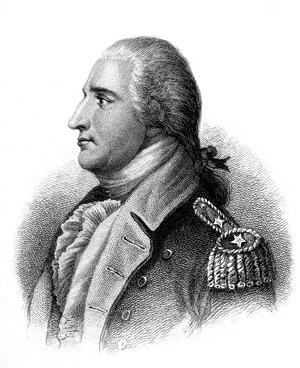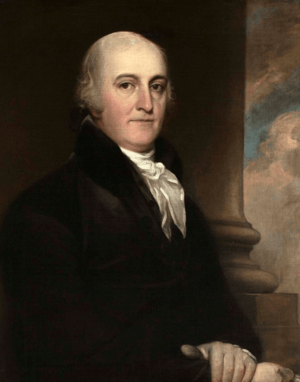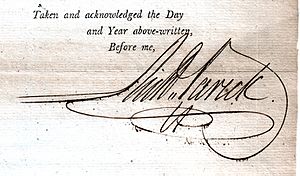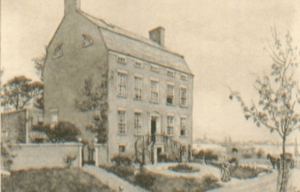Richard Varick facts for kids
Quick facts for kids
Richard Varick
|
|
|---|---|
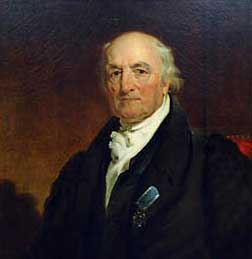
Portrait of Varick by Henry Inman (ca. 1831)
|
|
| 45th Mayor of New York City | |
| In office October 12, 1789 – December 31, 1801 |
|
| Preceded by | James Duane |
| Succeeded by | Edward Livingston |
| Governor | George Clinton (1789 - 1795) John Jay (1795 - 1801) |
| 2nd Attorney General of New York | |
| In office May 14, 1788 – September 29, 1789 |
|
| Governor | George Clinton |
| Preceded by | Egbert Benson |
| Succeeded by | Aaron Burr |
| 6th Speaker of the York State Assembly | |
| In office January 12, 1787 – December 10, 1788 |
|
| Preceded by | John Lansing Jr. |
| Succeeded by | John Lansing Jr. |
| 15th Recorder of New York City | |
| In office February 20, 1784 – September 29, 1789 |
|
| Preceded by | John Watts |
| Succeeded by | Samuel Jones |
| Personal details | |
| Born | March 15, 1753 Hackensack, Bergen County, Province of New Jersey |
| Died | July 30, 1831 (aged 78) Jersey City, New Jersey |
| Resting place | First Reformed Dutch Church Cemetery |
| Nationality | American |
| Political party | Federalist |
| Spouse | Maria Roosevelt |
| Military service | |
| Branch/service | |
| Years of service | 1775 - 1784 Continental Army 1784 - 1801 New York State Militia |
| Rank | |
Richard Varick (born March 15, 1753 – died July 30, 1831) was an important American lawyer, military officer, and politician. Some people call him "The Forgotten Founding Father." He played a big part in building New York City and New York State after America became independent. Varick became the 45th Mayor of New York City in 1789. He served for eleven years until 1801.
Before becoming mayor, Varick was the Recorder of New York City from 1784 to 1789. This job, which no longer exists, was like being the 'Chief Legal Officer'. With Samuel Jones, Varick helped write New York State's first laws after the American Revolution. These laws, called the Laws of New York (1789), set up the legal system for New York. As mayor, Varick used this groundwork to create important rules for the city. Under his leadership, early versions of the New York City Department of Health and the New York Stock Exchange were started. These helped build the New York City we know today.
During the Revolutionary War, Varick worked as George Washington's special assistant and private secretary. His work from this time became the Varick Transcripts, which are now kept at the Library of Congress. These documents are very valuable for understanding how the United States was formed.
Varick also helped start the Society of the Cincinnati and the American Bible Society. He was a long-time leader at Columbia University, serving as chairman of the board from 1810 to 1816.
Contents
Early Life and Family Background
Richard Varick was born on March 15, 1753, in Hackensack, New Jersey. His parents were John Varick and Jane (née Dey) Varick. His family's ancestors came to America with the Dutch West India Company in the 1600s. They settled in the New York City area. One of Varick's ancestors was Joris Jansen Rapelje. He was part of the Council of Twelve Men, which was the first democratic group in the United States in 1641. Varick's mother's father was a colonel in the Continental Army. His house, the Dey Mansion, was very important during the American Revolution.
Varick was one of seven children. His siblings included Abraham Varick, Dr. John Varick Jr., Anne Elting, Sarah Froeligh, Jane De Witt, and Maria Gilbert.
Varick's Education
We don't know much about Varick's early schooling. However, letters show he had private tutors and studied subjects like Latin and French. In 1771, he started at King's College in New York City. This college is now known as Columbia University. He studied there under John Morin Scott. Varick worked for Scott while he was a student. After he passed the New York Bar exam in October 1774, Scott offered him a partnership in his law firm. It was unusual because Varick had not yet officially graduated from King's College. Later in his life, Varick served as a trustee for Columbia University for over thirty years.
Military Career During the Revolution
Serving in the Continental Army
Just eight months after starting his law career, the American Revolutionary War began. His boss, John Morin Scott, encouraged Varick to join the military. On June 28, 1775, Varick became a captain in the 1st New York Regiment. After only three days, he was made military secretary to General Philip Schuyler. Schuyler was in charge of the Northern Army. It is believed that Scott helped Varick get this important job because he knew Varick was smart and good at organizing. Varick left New York City with Schuyler on July 4, 1775. They headed north to Fort Ticonderoga to fight the British in Canada. On the way, Varick met General Benedict Arnold in Albany. Arnold became a good friend of Varick's until Arnold betrayed America in 1780.
By the summer of 1776, General Schuyler was sick and had lost some battles. Varick was doing three jobs at once: he was Schuyler's private secretary, he managed supplies for all the northern forts, and he was the Northern Army's deputy muster master general. Generals Arnold and Horatio Gates were leading the battles. Schuyler saw how much work Varick was doing and promoted him to Lieutenant Colonel. Varick's control over the Northern Army's paperwork made him even closer friends with Arnold.
That same summer, Arnold planned to stop the British on Lake Champlain. This was one of the first battles for the U.S. Navy. There were not enough ships, so Varick helped build many of them from scratch. He contacted his network in New York City to get materials and skilled workers. The Battle of Valcour Island was a loss for the navy, but it slowed the British advance for the winter.
Varick also had problems with other officers. General Anthony Walton White accused Varick of speaking badly about him. White challenged Varick to a duel. Varick, who was not armed, barely escaped White's attempt to hurt him after he refused the challenge.
After the loss of Fort Ticonderoga, the Continental Congress removed Schuyler from his command in August 1777. General Gates took his place. Varick was friends with Arnold, which put him against Gates, whom he did not like. Varick, Arnold, Henry Brockholst Livingston, and Matthew Clarkson were a close group. They were sometimes called "The New York Gang" by others.
Varick continued his job as the Northern Army's deputy muster master general. He did this until January 12, 1780, when the Continental Congress closed his department.
Working for General Arnold
Varick briefly went back to his law practice. This was hard because New York City was controlled by the British. In August 1780, Benedict Arnold asked Varick to join his team at West Point. Arnold was the new commanding officer there. Varick became his special assistant and inspector-general.
Within three months, Arnold's betrayal was discovered, and he ran away to British territory. Varick and David Franks were arrested. Varick was sick in bed when he heard about Arnold's treason and his own arrest. People at the time said Varick was very upset about Arnold's actions. Arnold wrote to Washington saying his assistants were not involved. But Washington still held Varick and Franks as a safety measure. After an investigation, Varick was found innocent. The court said:
“Lieutenant Colonel Varick’s conduct... is not only unimpeachable but think him entitled... to a degree of Merit that does him great honor as an Officer and particularly distinguishes him as a sincere Friend to his Country…”
Working for General Washington
Because of this event, Varick met George Washington. They worked together for the rest of their lives. In 1781, Washington asked the Continental Congress to create a team of writers. Their job was to record and save all of his and the army's papers. This would be for future generations. Washington said this job needed "a Man of character in whom entire confidence can be placed." He chose Varick for this role. This job used Varick's great organizing skills and cleared his name after the Arnold scandal. Varick set up his office in Poughkeepsie. He and his helpers spent over two years putting together the forty-four volumes known as the Varick Transcripts. Varick worked only for Washington until Washington left the army in 1783.
After Varick finished his work, General Washington wrote to him:
“I take this first opportunity of signifying my entire approbation of the manner in which you have executed the important duties of recording secretary; and the satisfaction I feel in having my papers so properly arranged, and so correctly recorded; and beg you will accept my thanks for the care and attention which you have given to this business and beg you be persuaded, that I shall take pleasure in asserting on every occasion, the sense of entertainment of the fidelity, skill and indefatigable industry manifested by you in the performance of your public duties."
After leaving the Continental Army, Varick continued to serve as a colonel in the New York State Militia until 1801.
The Varick Transcripts
The Varick Transcripts are kept at the Library of Congress. These documents are very important for understanding how the United States was formed.
General Washington asked Colonel Varick to organize, copy, and put together all of Washington's papers. The 44 books contain copies of documents from May 1775 to June 1785. The papers, records, and letters are organized into different groups.
Society of the Cincinnati
In 1783, the Society of the Cincinnati was founded. Varick was one of its first members. He was also the president of the New York chapter from 1783 until he died in 1831. Only officers who had served at least three years in the Continental Army or Navy could usually join. The first meeting was held in May at Mount Gulian in Fishkill, New York. This was before the British left New York City. Varick's friend Lieutenant Colonel Alexander Hamilton led the meeting. The Society had three main goals: to protect the rights won in the war, to help the states stay united, and to assist members, their wives, and children who were in need.
Varick also helped keep the memory of George Washington alive. From 1790 to 1836, New York City celebrated Washington's birthday. These celebrations included dinners and parades.
Political Career in New York
Recorder and Attorney General (1784-1789)
Varick served as the Recorder of New York City from 1784 to 1789. This job was similar to being the city's chief legal officer. In this role, with Samuel Jones, he helped write New York State's first laws after the Revolution. These laws, called the Laws of New York (1789), set the groundwork for the Law of New York, the New York City Administrative Code, and the Rules of New York City.
At the same time, he was a member of the New York State Assembly for New York County from 1786 to 1788. He was also the Speaker of the Assembly in 1787 and 1788. Varick was then appointed the New York State Attorney General from 1788 to 1789.
Because of the New York State Constitution of 1777, most government jobs in New York City and State were appointed, not elected. So, in 1788, Varick held many important jobs at once. He was the Recorder of New York City, a State Assemblyman for New York City, the Speaker of the State Assembly, and the Attorney General of New York State. Varick himself said it was too many jobs for one person. But people at the time thought he was the best choice because he was an expert lawyer and organizer. They believed he could quickly build the new government systems for New York City and State.
Mayor of New York City (1789-1801)
Varick reached the peak of his political career as the Mayor of New York City. He served for twelve years, from 1789 to 1801. This was a time when the city was still growing after gaining independence. As mayor, he continued to build the systems that would make New York City a major business center in the United States. This was unique because the political capital of the country moved to Philadelphia, then Washington D.C.
In 1791, a major financial problem hit New York. It was caused by a plan to unfairly control the money markets, which had no rules at the time. Varick had to increase police officers to protect the people involved from angry crowds. This event led a group of merchants to create the "Buttonwood Agreement" in 1792. This agreement was the beginning of the New York Stock Exchange.
In the summer of 1793, a yellow fever outbreak caused many New Yorkers to leave the city. This epidemic led to the creation of what would become the New York City Department of Health. This was very helpful, as there were more outbreaks in the following years.
In 1794, people were angry about the Jay Treaty, which Varick supported. An angry crowd almost forced him out of the city.
Varick also faced problems when he tried to make licensed workers in the city vote for Federalist candidates. These workers included tavern keepers, grocers, butchers, and cartmen. This upset many people who believed in equal rights. Historians say Varick's strong-arm tactics pushed many workers away from the Federalists and towards the opposing Democratic-Republican group. In 1797, Aaron Burr took control of Tammany Hall. He used it to criticize Varick for his use of marketing and tax fees. Burr's party won the state's votes in the 1800 presidential election. This led to many Federalist politicians in New York losing their jobs, including Varick in 1801.
Life After Politics
Founding of Jersey City
In 1804, Varick was no longer in office and was not popular in New York City. He joined his friend Alexander Hamilton to create the Associates of the Jersey Company. This company helped build modern Jersey City through private development. The people behind the company were mostly Federalists. Like Varick and Hamilton, they had lost power in the 1800 election to Thomas Jefferson and other Democratic-Republicans. The company bought large areas of land in Paulus Hook. Varick and his two cousins, Anthony Dey and Jacob Radcliff, owned the titles to this land. Radcliff later became mayor of New York City twice. They planned the city squares and streets that are still there today. They named them after places in Lower Manhattan or after war heroes.
In 1816, Colonel Varick bought land on Essex Street and built Prospect Hall. This house overlooked the Hudson River. The property had lawns and gardens that went down to the water. Varick became a key figure in the continued development of Jersey City. He invited famous friends like Major General Marquis de Lafayette to visit during his tour of America in 1824. Varick lived at Prospect Hall until he died on July 30, 1831.
Founding of the American Bible Society
Varick was one of the founders of the American Bible Society in 1816. He later became its president in 1828, taking over from John Jay. He served as president until his death in 1831.
Personal Life
Richard Varick married Maria Roosevelt on May 8, 1786, in New York City. Maria was the daughter of Isaac Roosevelt. Her father was the great-great-grandfather of President Franklin Delano Roosevelt.
Varick and his wife first lived at 52 Wall Street. Then they moved to a bigger home on lower Broadway. They also owned a house at 11 Pearl Street in Lower Manhattan. Their last home was Prospect Hall on Essex Street in Jersey City, New Jersey.
Death and Burial
Varick died on July 30, 1831, at Prospect Hall. He is buried at the First Reformed Dutch Church Cemetery in Hackensack, New Jersey.
Places Named After Richard Varick
Varick Street in Manhattan (where he once owned property), Varick Street in Jersey City, and the Town of Varick, New York, are all named after him.



